Hyundai Matrix 2010 User Manual

CUSTOMER EXPERIENCE CENTER
1-800-331-4331
MATRIX
2 0 1 0
QUICK REFERENCE
GUIDE
Printed in U.S.A. 1/09
08-TCS-02938 |
00505-QRG10-MAT |
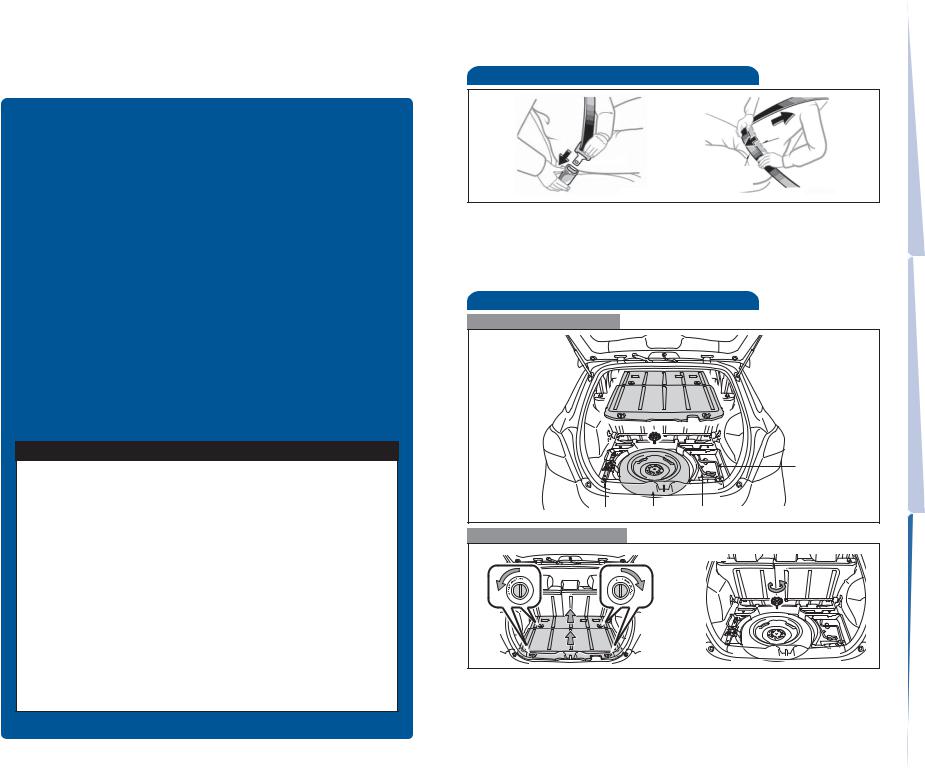
2010 Corolla Matrix
This Quick Reference Guide is a summary of basic vehicle operations. It contains brief descriptions of fundamental operations so you can locate and use the vehicle’s main equipment quickly and easily.
The Quick Reference Guide is not intended as a substitute for the Owner’s Manual located in your vehicle’s glove box. We strongly encourage you to review the Owner’s Manual and supplementary manuals so you will have a better understanding of your vehicle’s capabilities and limitations.
Your dealership and the entire staff of Toyota Motor Sales, U.S.A., Inc. wish you many years of satisfied driving in your new Corolla Matrix.
! A word about safe vehicle operations
This Quick Reference Guide is not a full description of Corolla Matrix operations. Every Corolla Matrix owner should review the Owner’s Manual that accompanies this vehicle.
Pay special attention to the boxed information highlighted in color throughout the Owner’s Manual. Each box contains safe operating instructions to help you avoid injury or equipment malfunction.
All information in this Quick Reference Guide is current at the time of printing. Toyota reserves the right to make changes at any time without notice.
Seatbelts
|
Take up slack |
OVERVIEW |
|
|
|
||
|
|
|
|
Too high |
|
||
Keep as low on hips as possible
If belt is fully extended, then retracted even slightly, it cannot be re-extended beyond that point, unless fully retracted again. This feature is used to help hold child restraint systems securely.
To find more information about seatbelts, and how to install a child restraint system, refer to the Owner's Manual.
Spare tire & tools
Tool location
FEATURES/OPERATIONS
Jack handle
|
Jack Spare tire Wheel nut wrench |
|
Removing the spare tire |
|
|
(1) |
(2) |
|
|
|
EMERGENCY AND SAFETY |
(1) |
Turn the knobs to the “UNLOCK” position and remove the deck boards. |
FEATURES |
|
||
(2) |
Loosen the center fastener that secures the spare tire. |
|
Refer to the Owner’s Manual for tire changing and jack positioning procedures.
21

INDEX
OVERVIEW
FEATURES/OPERATIONS
SAFETY AND EMERGENCY FEATURES
Engine maintenance |
7 |
Fuel tank door release and cap |
6 |
Hood release |
7 |
Indicator symbols |
5 |
Instrument cluster |
4 |
Instrument panel |
2-3 |
Keyless entry1 |
6 |
Air Conditioning/Heating |
16 |
Audio |
14-15 |
Auto lock functions2 |
8 |
Automatic Transmission |
8 |
Auxiliary storage |
17 |
Bottle holders |
19 |
Clock |
10 |
Cruise control |
17 |
Cup holders |
18 |
Door-Back |
13 |
Door locks-Power |
13 |
Light control-Instrument panel |
16 |
Lights & turn signals |
11 |
Moonroof |
13 |
Parking brake |
10 |
Power outlet-12V DC |
19 |
Power outlet-115V AC |
19 |
Seat adjustments-Front |
9 |
Seat adjustments-Rear |
9 |
Seats-Head restraints |
9 |
Telephone controls (Bluetooth®) |
18 |
Tilt and telescopic steering wheel |
10 |
Windows-Power |
12 |
Windshield wipers & washers |
12 |
Doors-Child safety locks |
20 |
Seatbelts |
21 |
Seatbelts-Shoulder belt anchor |
20 |
Spare tire & tools |
21 |
Tire Pressure Monitoring (warning) System 20
1 Visit your Toyota dealer for information on customizing this feature.
2Programmable by customer. Refer to the Owner’s Manual for instructions and more information.
OVERVIEW
 FEATURES/OPERATIONS
FEATURES/OPERATIONS
FEATURES EMERGENCY AND SAFETY
1

OVERVIEW
Instrument panel
Steering wheel controls
Steering wheel audio controls1,2 Voice command button1 Telephone controls1
Ignition switch Cruise control1
VSC/TRAC OFF switch Auxiliary storage
Power outside rearview mirror control
Headlight, turn signal and front fog light1 controls Wiper and washer controls
“AIR BAG ON” and “AIR BAG OFF” indicator Front passenger seatbelt reminder light Engine immobilizer indicator
Emergency flasher button
2
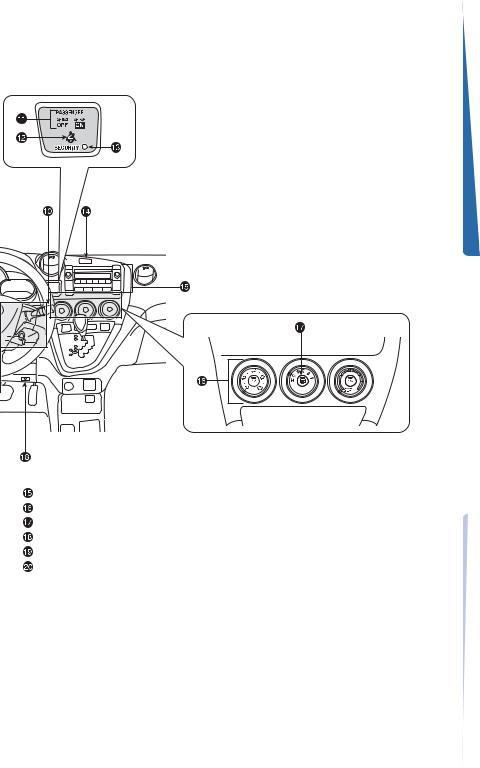
Audio system2
Air Conditioning controls
Outside rearview mirrors1/Rear window defogger button Tire Pressure Monitoring (warning) System reset
Tilt and telescopic steering control Hood lock release lever
1 If equipped
2Vehicles with navigation system: for details, refer to the “Navigation System Owner’s Manual.”
OVERVIEW
 FEATURES/OPERATIONS
FEATURES/OPERATIONS
FEATURES EMERGENCY AND SAFETY
3
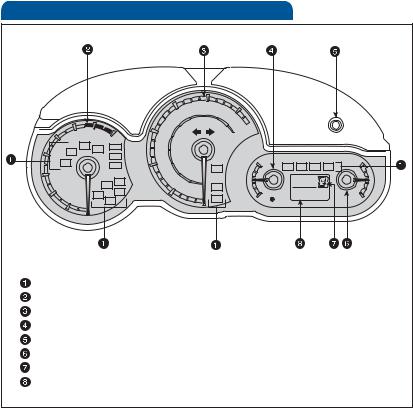
OVERVIEW
Instrument cluster
Service indicator and reminder Tachometer
Speedometer Fuel gauge
Trip meter reset/Instrument panel light control Engine coolant temperature
Automatic Transmission shift range display (if equipped) Odometer and two trip meters
4

Indicator symbols
For details, refer to “Indicators and warning lights,” Section 2-2, 2010
Owner’s Manual.

 Brake system warning1
Brake system warning1
Driver seatbelt reminder
(alarm will sound if speed is over 12 mph)
Front passenger seatbelt reminder
(alarm will sound if speed is over 12 mph)
 Charging system warning1
Charging system warning1


 AIR BAG ON and AIR BAG OFF indicator1
AIR BAG ON and AIR BAG OFF indicator1
Electric power steering warning1
 Malfunction/Check Engine indicator1
Malfunction/Check Engine indicator1
Low fuel level warning
 Open door warning
Open door warning
SRS Airbag warning1
Low Tire Pressure Warning1




 Headlight low/high beam indicator
Headlight low/high beam indicator



 Turn signal indicator
Turn signal indicator


 Fog light indicator
Fog light indicator
Slip indicator1
Cruise control indicator
 Anti-lock Brake System warning1
Anti-lock Brake System warning1
Vehicle Stability Control OFF indicator1


 Low engine oil pressure warning1
Low engine oil pressure warning1
Engine oil replacement reminder1



 Active torque control 4WD system warning1
Active torque control 4WD system warning1
1If indicator does not turn off within a few seconds of starting engine, there may be a malfunction. Have vehicle inspected by your Toyota dealer.
OVERVIEW
 FEATURES/OPERATIONS
FEATURES/OPERATIONS
FEATURES EMERGENCY AND SAFETY
5
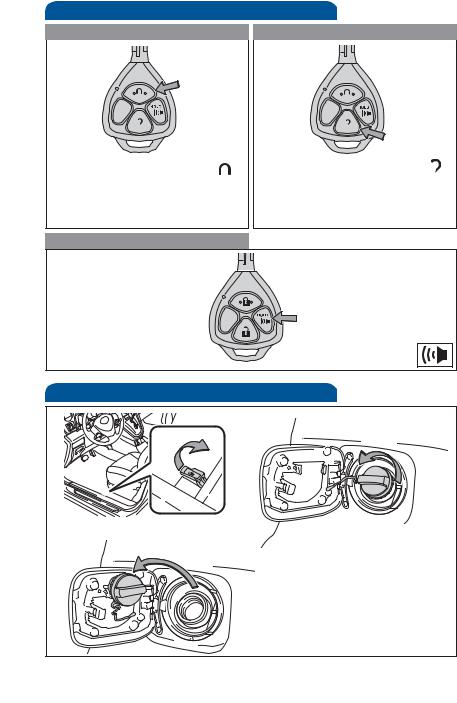
OVERVIEW
Keyless entry (if equipped)
Locking operation |
Unlocking operation |
|
|
|
|
|
|
|
|
|
|
|
|
|
|
|
|
|
|
|
|
|
|
|
|
|
|
|
|
|
|
|
|
|
|
|
|
|
|
Push ONCE: Driver door |
|
|
|
||
|
|
|
|
|
|
|
|
|||
|
Push |
|
|
|
TWICE: All doors |
|
|
|
||
|
|
|
|
|
|
|
|
|
|
|
|
|
|
|
|
|
|
|
|
|
|
NOTE: If a door is not opened within 60 seconds of unlocking, all doors will relock for safety.
Panic button
Push and hold
Fuel tank door release and cap
Pull |
Turn |
Store
NOTE: Tighten until one click is heard. If the cap is not tightened enough, Check Engine “ ” indicator may illuminate.
” indicator may illuminate.
6
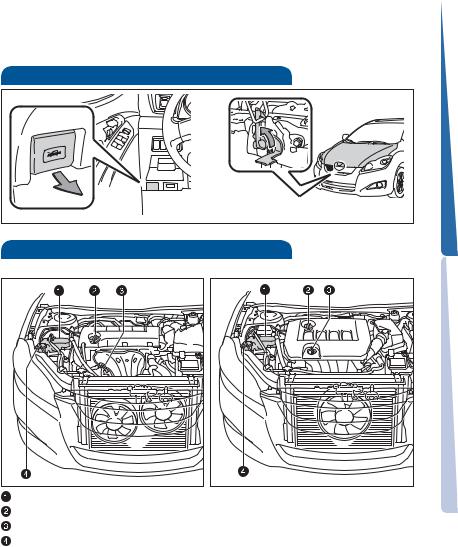
Hood release
|
OVERVIEW |
|
Pull |
Pull up latch |
|
and raise hood |
||
|
Engine maintenance
4 cylinder (2AZ-FE) engine |
|
4 cylinder (2ZR-FE) engine |
FEATURES/OPERATIONS |
Engine coolant reservoir
Engine oil filler cap
Engine oil level dipstick
Windshield washer fluid tank
Note: Regularly scheduled maintenance, including oil changes, will help extend the life of your vehicle and maintain performance. Please refer to the “Owner’s Warranty Information Booklet,” “Scheduled Maintenance Guide” or “Owner’s Manual Supplement.”
 FEATURES EMERGENCY AND SAFETY
FEATURES EMERGENCY AND SAFETY
7
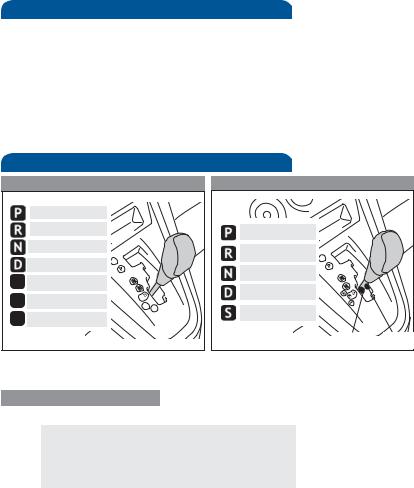
FEATURES/OPERATIONS
Auto lock functions (if equipped)
Automatic door locks can be programmed to operate in three different modes, or turned OFF.
-Doors lock when shifting from Park. -Doors unlock when shifting into Park.
-Doors unlock when the driver’s door is opened within 10 seconds after setting the engine switch to “ACC” or “LOCK” position.
Refer to the Owner’s Manual for more details.
Automatic Transmission (if equipped)
Standard type
Park*
Reverse
Neutral
Drive
3Third gear
2 Second gear
LFirst gear
3 |
|
2 |
L |
|
Multi-mode type
Park*
Reverse
Neutral
Drive
“S” mode
“S” “D”
*The ignition switch must be “ON” and the brake pedal depressed to shift from Park.
“S” (Sequential) mode
Shift the shift lever to “S” position from “D” position.
Floor shift type:
+: Upshift (push and release) -: Downshift (pull and release)
Downshifting increases power going uphill, or provides engine braking downhill. For best fuel economy during normal driving conditions, always drive with the shift lever in the “D” position.
8
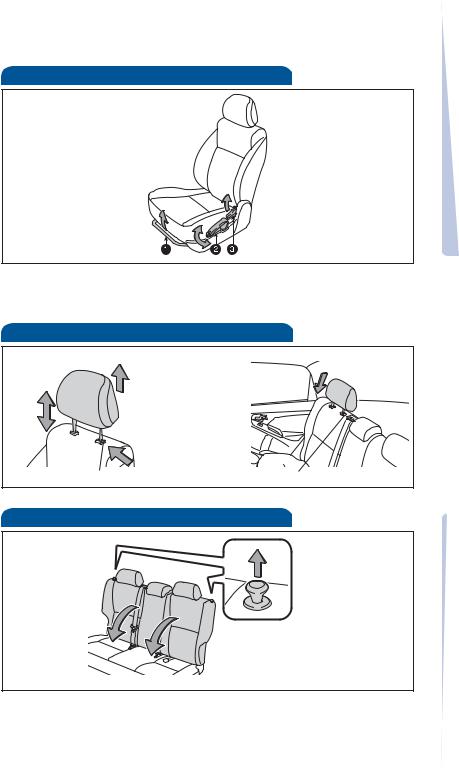
Seat adjustments-Front
 Position (forward/backward)
Position (forward/backward)
 Height crank (driver side only)
Height crank (driver side only)
 Seatback angle
Seatback angle
Seats-Head restraints
Front |
Rear |
|
|
|
|
Lock release button |
Lock release button |
Seat adjustments-Rear
Pull
Fold down
OVERVIEW
 FEATURES/OPERATIONS
FEATURES/OPERATIONS
FEATURES EMERGENCY AND SAFETY
9

FEATURES/OPERATIONS
Parking brake
Set |
Release |
(2) Push |
(1) Pull slightly |
|
Pull
(3) Lower 
Tilt and telescopic steering wheel
Lock release lever
Angle
 Length
Length
Hold wheel, push lever down, set angle and length, and return lever.
Note: Do not attempt to adjust while the vehicle is in motion.
Clock
Hour set
Minute set
Round off minutes
10

Lights & turn signals
Headlights
 Headlights
Headlights
Parking lights

 High beam
High beam
Low beam 



 High beam flasher
High beam flasher
-Daytime Running Light system (DRL) Headlights turn on automatically upon starting engine. The brightness of the headlights will automatically change depending on the darkness of the surroundings.
Front fog lights (if equipped)
Turn
Front fog lights come on only when the headlights are on low beam.
Turn signals
Right turn
Lane change
Lane change
Left turn 
OVERVIEW
 FEATURES/OPERATIONS
FEATURES/OPERATIONS
FEATURES EMERGENCY AND SAFETY
11
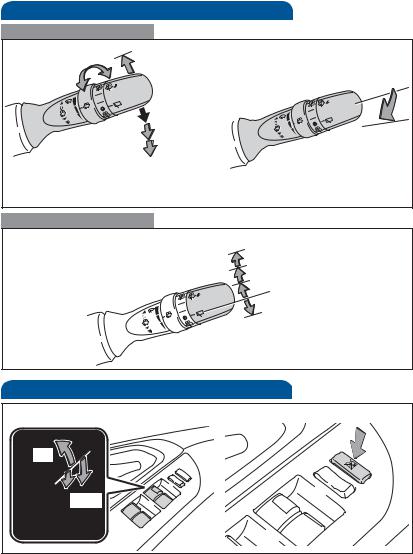
FEATURES/OPERATIONS
Windshield wipers & washers
Front
Adjust frequency* |
Single wipe |
|
Pull to wash |
||
|
and wipe
 Interval wipe
Interval wipe
 Slow
Slow
 Fast
Fast
*Intermittent windshield wiper frequency adjustment
Rotate to increase/decrease wipe frequency (if equipped).
Rear (if equipped)
Wash and wipe
Wipe
Interval wipe
Wash and wipe
Windows-Power (if equipped)
Driver side |
Window lock switch |
Up
Down
Automatic operation (driver side only) Push the switch completely down and release to fully open. To stop window midway, lightly push the switch in the opposite direction.
Window lock switch Deactivates all passenger windows. Driver’s window remains operable.
12

Moonroof (if equipped)
Sliding operation
Recommended driving position to minimize wind noise.
Open
Close
Push once to open partway; again to open completely.
Tilting operation
OVERVIEW |
Tilt |
Close |
Door-Back
Unlock Lock
Open
Door locks-Power (if equipped)
Unlock
Lock
 FEATURES/OPERATIONS
FEATURES/OPERATIONS
FEATURES EMERGENCY AND SAFETY
13
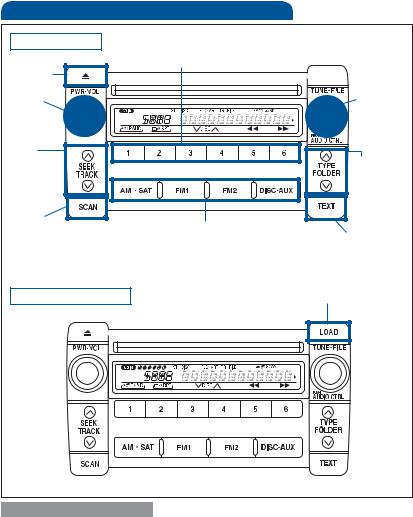
FEATURES/OPERATIONS |
|
Audio |
|
Type 1 functions |
|
Preset buttons - functions in other |
|
modes indicated above number |
|
Eject CD |
|
Push to |
Push and |
turn |
turn to |
ON/OFF |
adjust tone |
|
& balance |
Seek |
|
station/ |
Push to skip |
CD track |
up/down |
select |
folder and |
|
radio |
|
category |
Station/CD |
type |
Mode |
|
track scan |
View CD |
|
text |
Type 2 other functions |
Load CD(s) |
CD PLAYER
To scan tracks on a disc Push and hold “SCAN.” Push again to hold selection.
CD changer (Type 2)
-To load one disc Push “LOAD” and insert one disc.
-To load multiple discs Push and hold “LOAD” until you hear a beep. Insert one disc. Shutter will close and then re-open for next disc.
To select a file (MP3/WMA only) Turn “TUNE.FILE.”
14
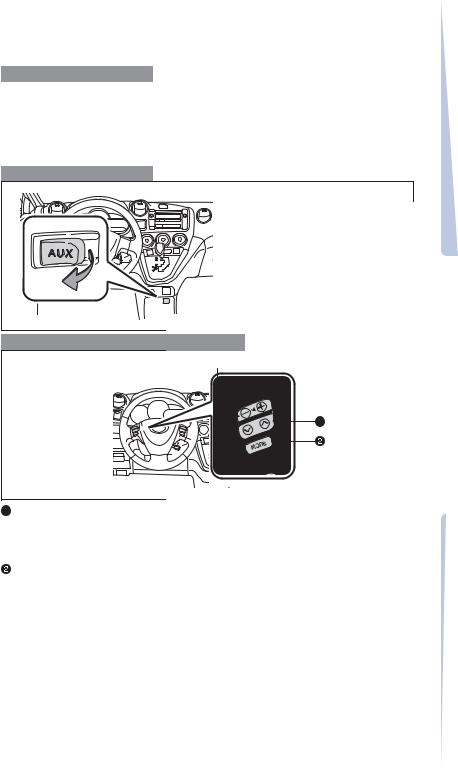
RADIO
To preset stations Tune in the desired station and hold down a preset button (1-6) until you hear a beep. Push desired preset button (1-6) to select.
To scan stations Push and hold “SCAN” to scan preset stations. Push again to hold selection.
AUX audio jack
By inserting a mini plug into the AUX audio jack, you can listen to music from a portable audio device through the vehicle’s speaker system while in AUX mode.
Steering wheel switches (if equipped)
Volume control
“ v v ”
-In radio mode Push to select a preset station; push and hold to seek the next strong station.
-In CD mode Push to skip up or down to next/previous track.
“MODE”
Push to turn audio ON and to select an audio mode. Push and hold to turn the audio system OFF.
OVERVIEW
 FEATURES/OPERATIONS
FEATURES/OPERATIONS
FEATURES EMERGENCY AND SAFETY
15
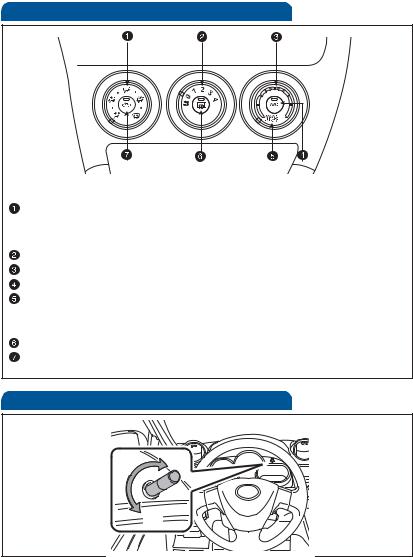
FEATURES/OPERATIONS
Air Conditioning/Heating
Airflow vent
In “ ” or “
” or “ ” mode, use fresh air (“
” mode, use fresh air (“ ” indicator OFF) to reduce window fogging.
” indicator OFF) to reduce window fogging.
Fan speed Temperature selector
Air Conditioning ON/OFF
Use for quick cooling. MAX A/C changes air intake to recirculate. It is not possible to change intake to fresh, or to turn A/C OFF in this mode.
Outside rearview mirror/Rear window defogger Fresh or recirculated cabin air
Light control-Instrument panel
Brightness control
+ |
- |
16
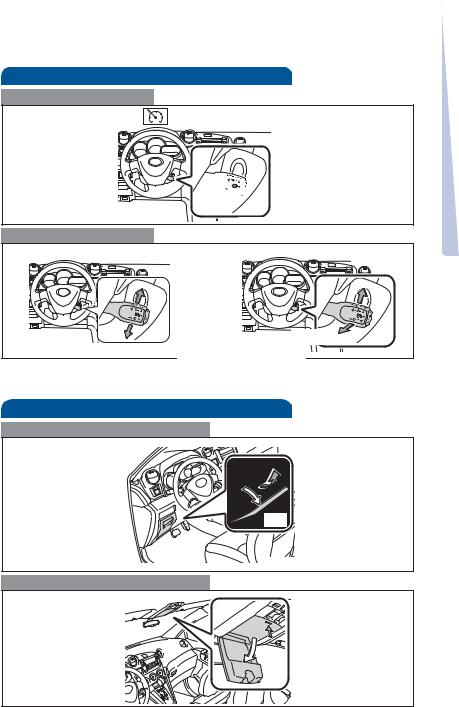
Cruise control (if equipped)
Turning system ON/OFF
OVERVIEW



 System ON/OFF
System ON/OFF
Functions |
|
Increase speed |
Resume2 |
|
Cancel1 |
Decrease speed |
|
1 The set speed may also be cancelled by depressing the brake pedal. 2 The set speed may be resumed once vehicle speed exceeds 25 mph.
Auxiliary storage
Instrument panel
 FEATURES/OPERATIONS
FEATURES/OPERATIONS
Pull
Overhead console (if equipped)
Push
 FEATURES EMERGENCY AND SAFETY
FEATURES EMERGENCY AND SAFETY
17
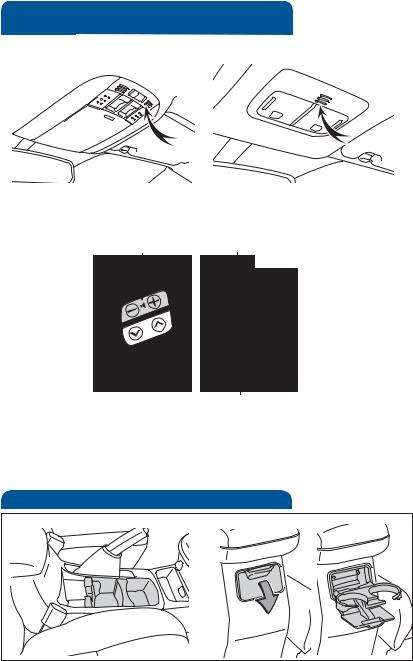
FEATURES/OPERATIONS
Telephone controls (Bluetooth®)
(if equipped)
Vehicles with moonroof |
|
|
|
|
Vehicles without moonroof |
|
|
|
|
|
|
|
|
|
|
|
|
|
|
|
|
|
|
|
|
|
|
Steering wheel telephone switches
Volume control |
Start call |
End call
Voice command button
Bluetooth® technology allows dialing or receive calls without taking hands from the steering wheel or using a cable to connect the compatible telephone and the system.
Refer to the Owner’s Manual for more details.
Cup holders
Front |
Rear |
|
18 |
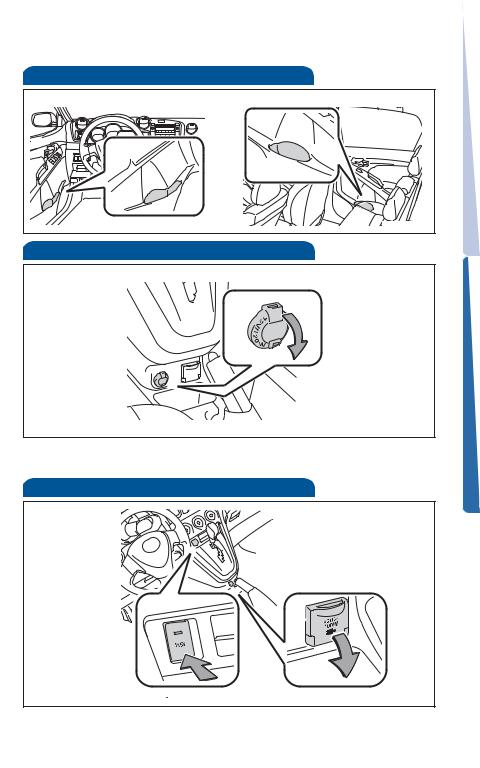
Bottle holders
Front |
Rear |
|
OVERVIEW |
Power outlet-12V DC
FEATURES/OPERATIONS
Designed for 12V car accessories.
The engine switch must be in the “ACC” or “ON” position.
Power outlet-115V AC (if equipped)
ON/OFF switch

Push
The engine switch must be in the “ON” position. Push the AC115V switch to use outlet.
 FEATURES EMERGENCY AND SAFETY
FEATURES EMERGENCY AND SAFETY
19
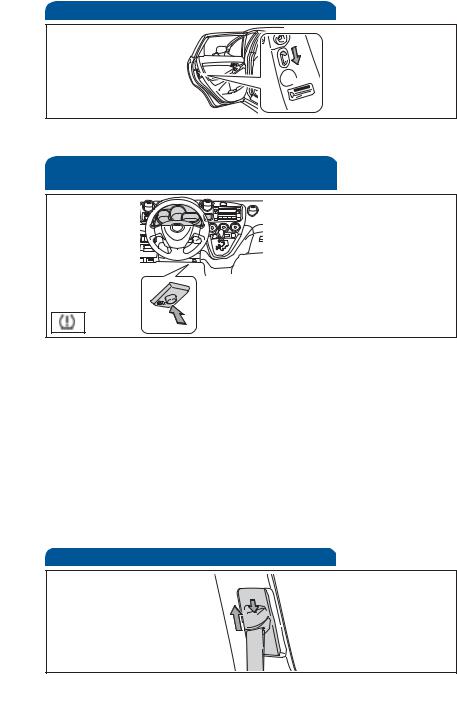
SAFETY AND EMERGENCY FEATURES
Doors-Child safety locks
Rear door
Moving the lever to “LOCK” will allow the door to be opened only from the outside.
Tire Pressure Monitoring (warning)
System
System reset initialization
1. Push and hold “ SET” button until the indicator blinks three times.
SET” button until the indicator blinks three times.
2. Wait a few minutes to allow initialization to complete.
After adjusting tire pressures, or after tires have been rotated or replaced, turn the ignition switch to “ON” and press and hold the
“  SET” button until indicator blinks three times. Let the vehicle sit for a few minutes to allow initialization to complete.
SET” button until indicator blinks three times. Let the vehicle sit for a few minutes to allow initialization to complete.
Refer to the load label on the door jamb or the Owner’s Manual for tire inflation specifications.
If the tire pressure indicator flashes for more than 60 seconds and then remains on, take the vehicle to your local Toyota dealer.
Note: The warning light may come on due to temperature changes or changes in tire pressure from natural air leakage. If the system has not been initialized recently, setting the tire pressures to factory specifications should turn off the light.
Seatbelts-Shoulder belt anchor
Push up, or squeeze 
 lock release to lower
lock release to lower 

20

Abbreviation list
Abbreviation/Acronym list
ABBREVIATIONS |
MEANING |
|
|
4WD |
4 Wheel Drive |
|
|
A/C |
Air Conditioning |
|
|
ABS |
Anti-lock Brake System |
|
|
ACC |
Accessory |
|
|
ALR |
Automatic Locking Retractor |
|
|
AWD |
All Wheel Drive |
|
|
CRS |
Child Restraint System |
|
|
ECU |
Electronic Control Unit |
|
|
EDR |
Event Data Recorder |
|
|
ELR |
Emergency Locking Retractor |
|
|
GAWR |
Gross Axle Weight Rating |
|
|
GVWR |
Gross Vehicle Weight Rating |
|
|
I/M |
Emission inspection and maintenance |
|
|
LATCH |
Lower Anchors and Tethers for Children |
|
|
LED |
Light Emitting Diode |
|
|
MMT |
Methylcyclopentadienyl Manganese Tricarbonyl |
|
|
M + S |
Mud and Snow |
|
|
MTBE |
Methyl Tertiary Butyl Ether |
|
|
OBD |
On Board Diagnostics |
|
|
SRS |
Supplemental Restraint System |
|
|
TIN |
Tire Identification Number |
|
|
TPMS |
Tire Pressure Warning System |
|
|
TRAC |
Traction Control |
|
|
VIN |
Vehicle Identification Number |
|
|
VSC |
Vehicle Stability Control |
|
|
436
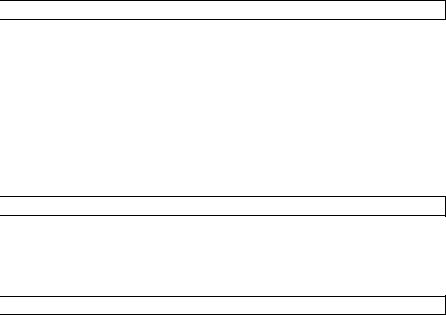
For your information
 Main Owner’s Manual
Main Owner’s Manual
Please note that this manual covers all models and all equipment, including options. Therefore, you may find some explanations for equipment not installed on your vehicle.
All specifications provided in this manual are current at the time of printing. However, because of the Toyota policy of continual product improvement, we reserve the right to make changes at any time without notice.
Depending on specifications, the vehicle shown in the illustrations may differ from your vehicle in terms of equipment.
 Noise from under vehicle after turning off the engine
Noise from under vehicle after turning off the engine
Approximately five hours after the engine is turned off, you may hear sound coming from under the vehicle for several minutes. This is the sound of a fuel evaporation leakage check and, it does not indicate a malfunction.
 Accessories, spare parts and modification of your Toyota
Accessories, spare parts and modification of your Toyota
A wide variety of non-genuine spare parts and accessories for Toyota vehicles are currently available on the market. You should know that these parts are not covered by Toyota warranty and that Toyota is not responsible for their performance, repair, or replacement, or for any damage they may cause to, or adverse effect they may have on, your Toyota vehicle.
This vehicle should not be modified with non-genuine Toyota products. Modification with non-genuine Toyota products could affect its performance, safety or durability, and may even violate governmental regulations. In addition, damage or performance problems resulting from the modification may not be covered under warranty.
18
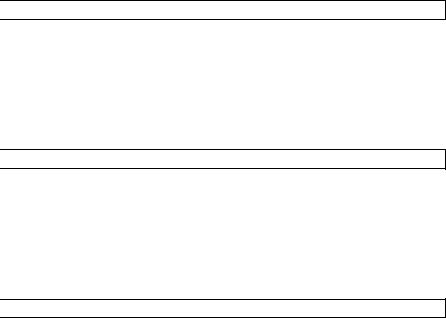
 Installation of a mobile two-way radio system
Installation of a mobile two-way radio system
As the installation of a mobile two-way radio system in your vehicle may affect electronic systems such as the multi-port fuel injection system/sequential multi-port fuel injection system, cruise control system, anti-lock brake system, SRS airbag system or seat belt pretensioner system, be sure to check with your Toyota dealer for precautionary measures or special instructions regarding installation.
 Scrapping of your Toyota
Scrapping of your Toyota
The SRS airbag and seat belt pretensioner devices in your Toyota contain explosive chemicals. If the vehicle is scrapped with the airbags and seat belt pretensioners left as they are, this may cause an accident such as fire. Be sure to have the systems of the SRS airbag and seat belt pretensioner removed and disposed of by a qualified service shop or by your Toyota dealer before you scrap your vehicle.
 Perchlorate Material
Perchlorate Material
Special handling may apply, See www.dtsc.ca.gov/hazardouswaste/perchlorate.
Your vehicle has components that may contain perchlorate. These components may include airbags, seat belt pretensioners, and wireless remote control batteries.
19

 CAUTION
CAUTION
■General precautions while driving
Driving under the influence: Never drive your vehicle when under the influence of alcohol or drugs that have impaired your ability to operate your vehicle. Alcohol and certain drugs delay reaction time, impair judgment and reduce coordination, which could lead to an accident that could result in death or serious injury.
Defensive driving: Always drive defensively. Anticipate mistakes that other drivers or pedestrians might make and be ready to avoid accidents.
Driver distraction: Always give your full attention to driving. Anything that distracts the driver, such as adjusting controls, talking on a cellular phone or reading can result in a collision with resulting death or serious injury to you, your occupants or others.
■General precaution regarding children’s safety
Never leave children unattended in the vehicle, and never allow children to have or use the key.
Children may be able to start the vehicle or shift the vehicle into neutral. There is also a danger that children may injure themselves by playing with the cigarette lighter, the windows, or other features of the vehicle. In addition, heat build-up or extremely cold temperatures inside the vehicle can be fatal to children.
20
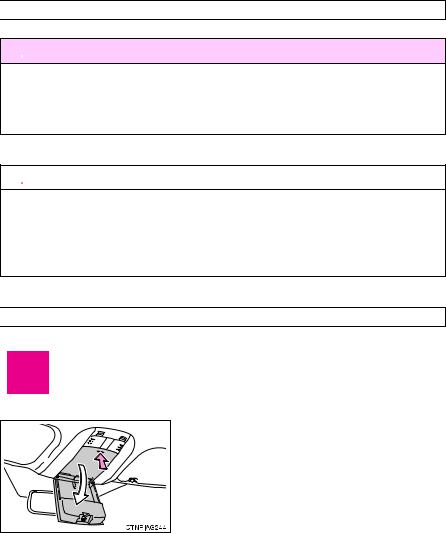
Symbols used throughout this manual
 Cautions & Notices
Cautions & Notices
 CAUTION
CAUTION
This is a warning against anything which may cause death or injury to people if the warning is ignored. You are informed about what you must or must not do in order to reduce the risk of injury to yourself and others.
 NOTICE
NOTICE
This is a warning against anything which may cause damage to the vehicle or its equipment if the warning is ignored. You are informed about what you must or must not do in order to avoid or reduce the risk of damage to your Toyota and its equipment.
 Symbols used in illustrations
Symbols used in illustrations
Safety symbol
The symbol of a circle with a slash through means “Do not”, “Do not do this”, or “Do not let this happen”.
Arrows indicating operations
 Indicates the action (pushing, turning, etc.) used to operate switches and other devices.
Indicates the action (pushing, turning, etc.) used to operate switches and other devices.
 Indicates the outcome of an operation (e.g. a lid opens).
Indicates the outcome of an operation (e.g. a lid opens).
21
22

TABLE OF CONTENTS
1 |
Before driving |
Adjusting and operating features such as door locks, |
|
mirrors, and steering column. |
|
||
|
|
|
|
|
|
|
|
2When driving Driving, stopping and safe-driving information.
3Interior fea- Air conditioning and audio systems, as well as other in-
tures |
terior features for a comfortable driving experience. |
4Maintenance and care
5Whenarisestrouble
6Vehiclespecifications
7For owners
Index
Cleaning and protecting your vehicle, performing do-it- yourself maintenance, and maintenance information.
What to do if the vehicle needs to be towed, gets a flat tire, or is involved in an accident.
Detailed vehicle information.
Reporting safety defects for U.S. owners and seat belt instructions for Canadian owners
Alphabetical listing of information contained in this manual.
1
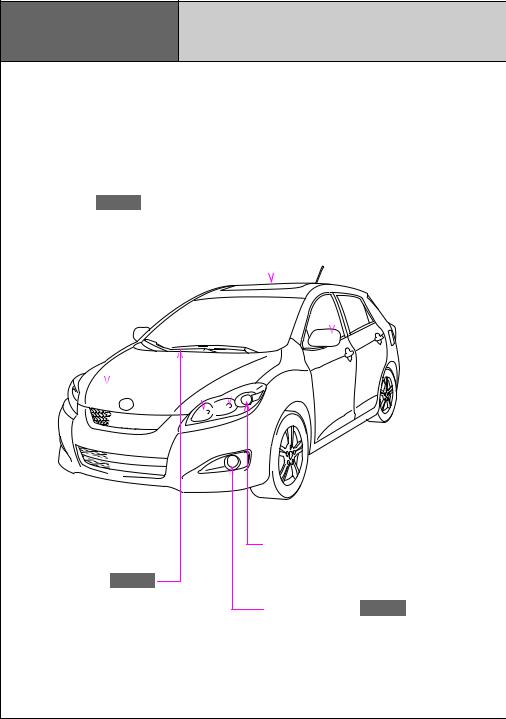
Pictorial index Exterior
|
|
|
|
|
|
|
Headlights (low beam) |
P. 132 |
|||||||
|
|
|
|
|
|
|
|||||||||
|
|
|
|
|
|
|
|
|
Moon roof |
|
|
||||
Headlights (high beam) |
|
|
|
|
|
|
|
P. 58 |
|
||||||
P. 133 |
|
|
|
|
|
|
|
||||||||
|
|
|
|
|
|
Outside rear view |
|||||||||
Hood P. 289 |
|
|
|
|
|
|
|
|
|||||||
|
|
|
|
|
|
|
|
||||||||
|
|
|
|
|
|
|
|
||||||||
|
|
|
|
|
|
|
|
mirrors |
|
P. 54 |
|
|
|||
|
|
|
|
|
|
|
|
|
|
|
|
|
|||
|
|
|
|
|
|
|
|
|
|
|
|
|
|
|
|
|
|
|
|
|
|
|
|
|
|
|
|
|
|
|
|
|
|
|
|
|
|
|
|
|
|
|
|
|
|
|
|
|
|
|
|
|
|
|
|
|
|
|
|
|
|
|
|
|
|
|
|
|
|
|
|
|
|
|
|
|
|
|
|
Front turn signal/parking and front side marker lights 
Windshield wipers P. 136
Front fog lights P. 135
6
